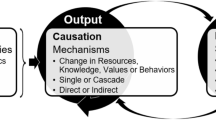Abstract
Despite the increased attention that the topic of aging and technology is receiving from academia, policy and business practice, both conceptual and empirical research in this area is still scarce. Particularly, there seems to be a dearth of applications of well-grounded and established frameworks from the field of innovation and technology management to the case of older consumers and the “silver market.” Through an approach that combines conceptual development with explorative empirical research using the disruptive innovation framework, we find that: 1) the silver market is an excellent field of application for low-end disruptions as elderly customers will increasingly demand just-good-enough performance—easy and safe to use—and affordable products and services; 2) the silver market is an excellent field of application for new market disruptions as elderly customers will increasingly demand new products and services they had not demanded or had not been able to demand before; 3) transgenerational and ageless products and services are an excellent field of application for disruptive innovations; 4) disruptive innovations for the silver market are particularly effective and easy to adopt and use due to their good-enough functionality and performance (including ease of use) and affordability, and this helps to increase their diffusion among older consumers.

Similar content being viewed by others
References
Adner, R. (2002). When are technologies disruptive? A demand-based view of the emergence of competition. Strategic Management Journal, 23(8), 667–688.
Barak, B., & Schiffman, L. G. (1981). Cognitive age: A nonchronological variable. In K. B. Monroe (Ed.), Advances in consumer research (Vol. 8, pp. 602–606). Ann Arbor: Association for Consumer Research.
Bengtson, V. L., Gans, D., Putney, N. M., & Silverstein, M. (Eds.). (2009). Handbook of Theories of Aging (2nd ed.). New York: Springer.
Bröring, S., Cloutier, L. M., & Leker, J. (2006). The front end of innovation in an era of industry convergence: evidence from nutraceuticals and functional foods. R&D Management, 36(5), 487–498.
Burdick, D. C., & Kwon, S. (Eds.). (2004). Gerotechnology: Research and practice in technology and aging. New York: Springer.
Butler, J. (2004). New challenges for R&D management. In European Institute for Technology and Innovation Management (Ed.), Bringing technology and innovation into the boardroom: Strategy, innovation and competences for business value (pp. 269–291). Basingstoke: Macmillan.
Christensen, C. M. (1997). The innovator's dilemma: When new technologies cause great firms to fail. Boston: Harvard Business School Press.
Christensen, C. M. (2006). The ongoing process of building a theory of disruption. Journal of Product Innovation Management, 23(1), 39–55.
Christensen, C. M., Anthony, S. D., & Roth, E. A. (2004). Seeing what's next: Using the theories of innovation to predict industry change. Boston: Harvard Business School Press.
Christensen, C. M., & Raynor, M. E. (2003). The innovator’s solution: Creating and sustaining successful growth. Boston: Harvard Business School Press.
Coulmas, F., Conrad, H., Schad-Seifert, A., & Vogt, G. (Eds.). (2008). The demographic challenge: A handbook about Japan. Leiden: Brill.
Cutler, S. J. (2005). Ageism and technology. Generations, 29(3), 67–72.
Czaja, S. J., Guerrier, J. H., Nair, S. N., & Landauer, T. K. (1993). Computer communication as an aid to independence for older adults. Behaviour & Information Technology, 12(4), 197–207.
Czaja, S. J., & Schulz, R. (2006). Innovations in technology and aging: Introduction. Generations, 30(2), 6–8.
Czaja, S. J., & Sharit, J. (1998). Age differences in attitudes toward computers. Journal of Gerontology: Psychological sciences, 53B(5), 329–340.
Drucker, P. F. (1985). Innovation and entrepreneurship: Practice and principles. New York: HarperCollins.
Drucker, P. F. (2002). Managing in the next society. New York: Truman Talley Books, St. Martin's Griffin.
Druehl, C. T., & Schmidt, G. M. (2008). A strategy for opening a new market and encroaching on the lower end of the existing market. Production and Operations Management, 17(1), 44–60.
Fitzgerald, T. K. (1999). The elderly at the millennium: courting the older consumer. Ageing International, 25(1), 72–86.
Gilly, M. C., & Zeithaml, V. (1985). The elderly consumer and adoption of technologies. Journal of Consumer Research, 12(3), 353–357.
Gitlin, L. N. (1995). Why older people accept or reject assistive technology. Generations, 19(1), 41–46.
Govindarajan, V., & Kopalle, P. K. (2006a). Disruptiveness of innovations: measurement and an assessment of reliability and validity. Strategic Management Journal, 27(2), 189–199.
Govindarajan, V., & Kopalle, P. K. (2006b). The usefulness of measuring disruptiveness of innovations ex post in making ex ante predictions. Journal of Product Innovation Management, 23(1), 12–18.
Hall, J. K., & Martin, M. J. C. (2005). Disruptive technologies, stakeholders and the innovation value-added chaing: a framework for evaluating radical technology development. R&D Management, 35(3), 273–284.
Hooyman, N. R., & Kiyak, H. A. (2005). Social gerontology: A multidisciplinary perspektive. Boston: Pearson.
Hough, M., & Kobylanski, A. (2009). Increasing elder consumer interactions with information technology. Journal of Consumer Marketing, 26(1), 39–48.
Hüsig, S., Hipp, C., & Dowling, M. (2005). Analysing disruptive potential: the case of wireless local area network and mobile communications network companies. R&D Management, 35(1), 17–35.
Irie, T., Matsunaga, K., & Nagano, Y. (2005). Universal design activities for mobile phone: Raku Raku PHONE. Fujitsu Scientific and Technical Journal, 41(1), 78–85.
Kawamoto, H., & Sankai, Y. (2005). Power assist method based on phase sequence and muscle force condition for HAL. Advanced Robotics, 19(7), 717–734.
Kinney, J. M., Kart, C. S., Murdoch, L. D., & Ziemba, T. F. (2003). Challenges in caregiving and creative solutions: using technology to facilitate caring for a relative with dementia. Ageing International, 28(3), 295–314.
Kohlbacher, F., & Hang, CC (2007). Disruptive innovations and the graying market. Proceedings of the 2007 IEEE International Conference on Industrial Engineering and Engineering Management (IEEM) (pp. 1915–1919), Singapore.
Kohlbacher, F., & Herstatt, C. (2009). "Silver Products" development: The reality of R&D in firms in Japan. Paper presented at the The R&D Management Conference 2009, Vienna, Austria.
Kohlbacher, F., & Herstatt, C. (Eds.). (2008). The silver market phenomenon: Business opportunities in an era of demographic change. Heidelberg: Springer.
Kohlbacher, F., & Hideg, A. (2010). Raku-Raku Phone: Einfach telefonieren—einfach erfolgreich. JapanMarkt, May 2010, 22–25.
Lai, O.-K. (2008). The enigma of Japanese ageing-in-place practice in the information age: Does digital gadget help the (good) practice for inter-generation care? Ageing International, 32(3), 236–255.
Langer, J. (1984). Changing demographics: stimulus for new product ideas. Journal of Consumer Marketing, 1(2), 35–43.
Levkoff, S. E. (2000). Graying of Japan: Choju shakai. Ageing International, 26(1–2), 10–24.
Lunsford, D. A., & Burnett, M. S. (1992). Marketing product innovations to the elderly: understanding the barriers to adoption. Journal of Consumer Marketing, 9(4), 53–63.
Magnus, G. (2009). The age of aging: How demographics are changing the global economy and our world. Singapore: John Wiley & Sons (Asia) Pte. Ltd.
Mann, W. C. (Ed.). (2005). Smart technology for aging, disability, and independence: The state of the science. Hoboken: Wiley.
Markides, C. (2006). Disruptive innovation: in need of better theory. Journal of Product Innovation Management, 23(1), 19–25.
Mathur, A. (1999). Adoption of technological innovations by the elderly: a consumer socialization perspective. The Journal of Marketing Management, 9(3), 21–35.
McMellon, C. A., & Schiffman, L. G. (2002). Cybersenior empowerment: how some older individuals are taking control of their lives. Journal of Applied Gerontology, 21(2), 157–175.
Mellor, D., Firth, L., & Moore, K. (2008). Can the internet improve the well-being of the elderly? Ageing International, 32(1), 25–42.
Moody, H. R. (2002). Aging: Concepts and controversies (4th ed.). Thousand Oaks: Sage.
Moschis, G. P. (1996). Gerontographics: Life-stage segmentation for marketing strategy development. Westport: Quorum.
Moschis, G. P. (2007). Life course perspectives on consumer behavior. Journal of the Academy of Marketing Science, 35(2), 295–307.
Mynatt, E. D., & Rogers, W. A. (2001). Developing technology to support the functional independence of older adults. Ageing International, 27(1), 24–41.
Niemelä-Nyrhinen, J. (2007). Baby boom consumers and technology: shooting down stereotypes. Journal of Consumer Marketing, 24(5), 305–312.
Philips, L. W., & Sternthal, B. (1977). Age differences in information processing: a perspective on the aged consumer. Journal of Marketing Research, 14(4), 444–457.
Pirkl, J. J. (1994). Transgenerational design: Products for an aging population. New York: Van Nostrand Reinhold.
Powell, J. L. (2010). The power of global aging. Ageing International, 35(1), 1–14.
Robinson, B. (1995). Technology and aging: a separate little world? Ageing International, 22(1), 54–55.
Rogers, E. M. (2003). Diffusion of innovations (5th ed.). New York: Free.
Rowe, J. W., & Kahn, R. L. (1987). Human aging: usual and successful. Science, 237(4811), 143–149.
Rowe, J. W., & Kahn, R. L. (1997). Succesful aging. The Gerontologist, 37(4), 433–440.
Schmidt, G. M. (2004). Low-end and high-end encroachment strategies for new products. International Journal of Innovation Management, 8(2), 167–191.
Schmidt, G. M., & Druehl, C. T. (2005). Changes in product attributes and costs as drivers of new product diffusion and substitution. Production and Operations Management, 14(3), 272–285.
Schmidt, G. M., & Druehl, C. T. (2008). When is a disruptive innovation disruptive? Journal of Product Innovation Management, 25(4), 347–369.
Sudbury, L., & Simcock, P. (2009). Understanding older consumers through cognitive age and the list of values: a U.K.-based perspective. Psychology & Marketing, 26(1), 22–38.
Suzuki, K., Mito, G., Kawamoto, H., Hasegawa, Y., & Sankai, Y. (2007). Intention-based walking support for paraplegia patients with robort suit HAL. Advanced Robotics, 21(12), 1441–1469.
Tempest, S., Barnat, C., & Coupland, C. (2002). Grey advantage: new strategies for the old. Long Range Planning, 35(5), 475–492.
Thompson, M. (1996). Computer technology: how it impacts the lives of older adults. Ageing International, 23(1), 85–91.
Tielen, G. (1998). Integrating senior citizens into the information society. Ageing International, 24(2–3), 143–153.
Tsuno, N., & Homma, A. (2009). Ageing in Asia—the Japan experience. Ageing International, 34(1–2), 1–14.
Uhl, K., Andrus, R., & Poulsen, L. (1970). How are laggards different? An empirical inquiry. Journal of Marketing Research, 7(1), 51–54.
Utterback, J. M., & Acee, H. J. (2005). Disruptive technologies: an expanded view. International Journal of Innovation Management, 9(1), 1–17.
Wada, K., & Shibata, T. (2007). Living with seal robots—its sociopsychological and physiological influences on the elderly at a care house. IEEE Transactions on Robotics, 23(5), 972–980.
Wada, K., Shibata, T., Musha, T., & Kimura, S. (2008). Robot therapy of elders affected by dementia. IEEE Engineering in Medicine and Biology Magazine, 27(4), 53–60.
Wolfe, D. B., & Snyder, R. E. (2003). Ageless marketing: Strategies for reaching the hearts & minds of the new customer majority. Chicago: Dearborn.
Wylde, M. A. (1995). How to size up the current and future markets: technologies and the older adult. Generations, 19(1), 15–19.
Yin, R. K. (2003a). Applications of case study research (2nd ed., Vol. 34)). Thousand Oaks: Sage.
Yin, R. K. (2003b). Case study research, design and methods (3rd ed., Vol. 5)). Thousand Oaks: Sage.
Yu, D., & Hang, C. C. (2009). A reflective review of disruptive innovation theory. International Journal of Management Reviews. doi:10.1111/j.1468-2370.2009.00272.x.
Zeithaml, V., & Gilly, M. C. (1987). Characteristics affecting the acceptance of retailing technologies: a comparison of elderly and nonelderly consumers. Journal of Retailing, 63(1), 49–68.
Conflict of Interest
Professor C.C. Hang is a non-executive director of Ampere Vehicles Pte Ltd in Singapore; this company has designed and manufactured e-bikes for the Indian market. One segment of the market is the aged or handicapped customers.
Author information
Authors and Affiliations
Corresponding author
Rights and permissions
About this article
Cite this article
Kohlbacher, F., Hang, C.C. Applying the Disruptive Innovation Framework to the Silver Market. Ageing Int 36, 82–101 (2011). https://doi.org/10.1007/s12126-010-9076-x
Published:
Issue Date:
DOI: https://doi.org/10.1007/s12126-010-9076-x




